Good to know
Find out more about Granville’s Upper Town, one of the 19 family outings available in the Granville Terre et Mer region!
 Aerial view of Granville's Upper Town
Aerial view of Granville's Upper Town View of Granville's rooftops from the Upper Town
View of Granville's rooftops from the Upper Town Rue Notre-Dame in Granville's Upper Town
Rue Notre-Dame in Granville's Upper TownStarting from the Place du Casino, i.e. “down below”, you can measure the height of this old rock. To avoid too steep a climb, it’s time to head for Rue des Juifs.
This street is the traditional route, once used by carts, to reach the foot of the ramparts. Its artistic ambience, with art galleries, bookshops, antique shops and other businesses, lends a quiet charm to this small ascent. Rue des Juifs owes its name to the settlement of Jewish families along what was to become Granville‘s first faubourg. At the time, only the north side of the street was built, as the sea was still pounding the rock on the south side.
Once you’ve reached the top of Rue des Juifs, you’ll enjoy your first view to the south. This is your chance to look for Mont Saint-Michel… Which you won’t find! In fact, the famous monument is hidden just behind the Pointe de Carolles. And that’s one of the reasons why Granville exists…
 Map of a stroll through Granville's Upper Town
Map of a stroll through Granville's Upper Town Map of Granville circa 1630
Map of Granville circa 1630In 1439, on the heights of Pointe du Roc, when this granite peninsula was inhabited only by a handful of fishermen, the English seneschal Sir Thomas de Scales decided to build a stronghold to advance his conquest of Norman lands. Why was this? Because this piece of rock was out of sight of Mont Saint-Michel, the goal of conquest so coveted by the English! They obtained the land by buying it from the local lord Jean d’Argouges, and began by digging a 7-metre-wide trench where the Casino now stands. This allowed them to establish the best natural defense of all: turning Granville into an island at high tide!
 View of Granville harbour's wet dock from the Upper Town
View of Granville harbour's wet dock from the Upper Town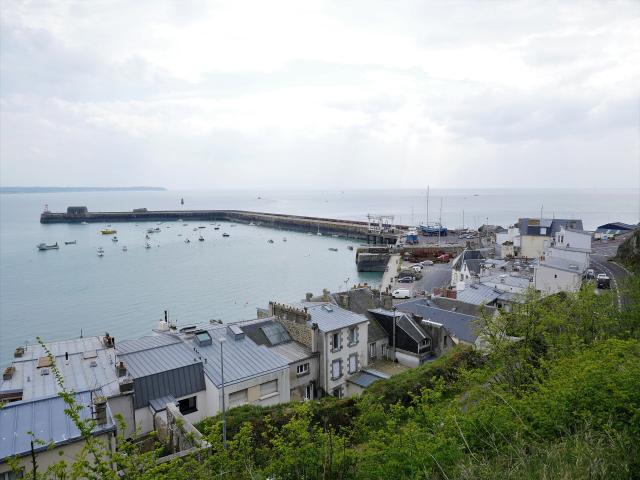 View of the outer harbour of the port of Granville from Haute Ville
View of the outer harbour of the port of Granville from Haute VilleGranville’s history was marked by a key military episode in the Vendée Wars. In the autumn of 1793, the royalist armies were in the midst of their “virée de galerne” following the defeat at Cholet. On November 14, they laid siege to Granville in order to control a port and rally the English. This battle saw more than 20,000 “white” soldiers confront 5,500 “blue” soldiers, aided by civilians who had taken refuge in the stronghold. With no effective siege equipment, a lot of bad information and more powerful artillery than expected, the Vendéens retreated on November 15 without seeing a single English vessel. The plaque under the porch lists the granvillais civilians who fell during this siege, including Jacques-François Clément-Desmaisons, a municipal officer, whose heroism has been immortalized in a painting by Maurice Orange.
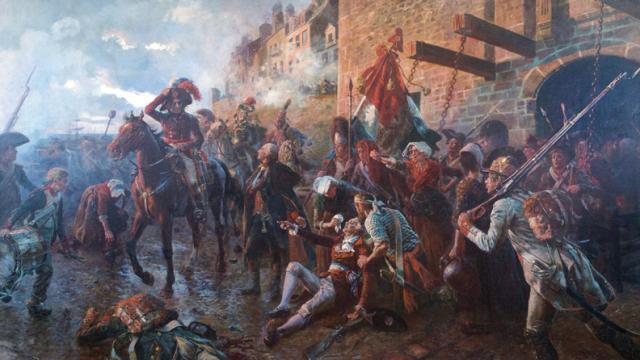 Episode of the siege of Granville (November 14, 1793) - The death of Mayor Clément-Desmaisons
Episode of the siege of Granville (November 14, 1793) - The death of Mayor Clément-DesmaisonsAfter crossing the drawbridge and winding up the cobbled street, you arrive at the heart of the Upper Town: Place Cambernon.
A few shops remain here, but you have to imagine that the whole area was full of stalls until the middle of the 20th century.
At the corner of rue Cambernon and rue Notre-Dame, you’ll see a plaque. It was recently unveiled by Prince Albert II of Monaco as a descendant of the Counts of Matignon. The Matignons ruled Granville for several generations and stayed in this private mansion. Jacques IV de Gouyon de Matignon became Jacques I de Grimaldi after the death of his wife, Louise-Hippolyte, Sovereign of Monaco. Was it then that Granville became known as the Monaco of the North? No, the origin of the nickname is more recent, but we must admit that these stories of crowned heads are always very juicy! All the more so since Jacques I was not a very exemplary husband…
 The lookout house rises above Granville's ramparts
The lookout house rises above Granville's rampartsThen head up Rue Notre-Dame towards the church and circle around to the south. You’ll pass the Maison du Guet. This charming building is an integral part of the fortified town’s skyline. Its medieval allure and Hogwarts-like turrets raise many questions. In fact, it’s a private seaside home dating back to the early 20th century. Astonishing, isn’t it? The view of the outer harbor and the basin is quite remarkable. Enter the church through a small door on the north side of the building.
A chapel was erected on this very site as early as the 12th century, when, according to legend, local fishermen miraculously caught a statue of the Virgin Mary in their nets. The foundations of today’s church date back to English times (1440), but it took more than three centuries for the building to take on its present form. Proudly perched on the Roc de Granville, the church’s body of Chausey granite is constantly battered by the sea spray. Inside, the church is definitely oriented towards the sea, with its north chapel dedicated to the Virgin and its south chapel dedicated to Saint-Clément, adorned with remarkable ex-votos. Last but not least, a tour of the ambulatory is an absolute must to see the magnificent stained glass windows by master glassworker Jacques Le Chevallier, dating from the second half of the 20th century.
 Notre-Dame du Cap Lihou church in Granville's Upper Town
Notre-Dame du Cap Lihou church in Granville's Upper TownNow you’re about to cross the whole district from west to east. Don’t worry, it’s only a 500m walk!
After visiting the church, head for the north rampart. You’ll find yourself near Granville’s former barracks, home to various infantry regiments until 1984. Enjoy the view and the spray from the windy Rue du Nord! You can see Chausey in the distance, this archipelago of a thousand mineral shades. Walk along the rampart and take a deep breath until you fork right into Rue des Platriers. Follow this road to reach the corner of rue du Marché au Pain and rue Notre-Dame.
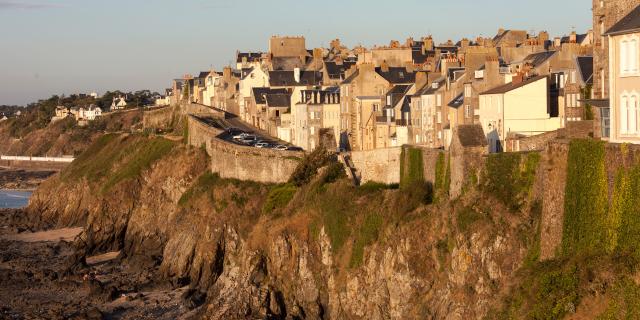 View of Granville's Upper Town and the ramparts of the North Shore
View of Granville's Upper Town and the ramparts of the North ShoreIf you stop at this crossroads, you’ll see both tenement buildings, where families lived in apartments, and private mansions. The latter often belonged to wealthy shipowners who contributed to the growth and renown of the port of Granville. Sometimes privateers, sometimes Newfoundlanders, Granville’s sailors have long been valiant adventurers, never really sure of returning home… That’s why, before each fishing season, they celebrated Carnival, a tradition that is still perpetuated today and recognized by Unesco.
You’re also standing in front of the Théâtre de la Haute Ville. This is an ancient court where the many commercial disputes that could arise in such a trading city were judged.
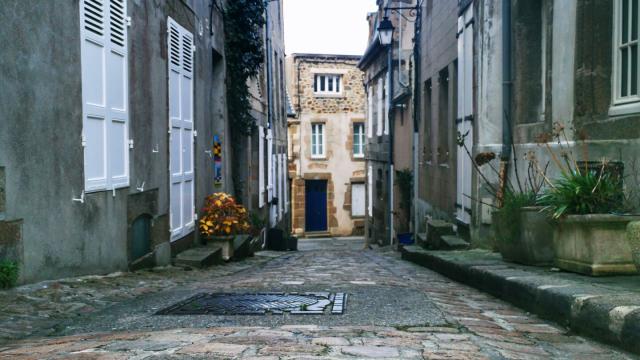 A street in Granville's Upper Town
A street in Granville's Upper Town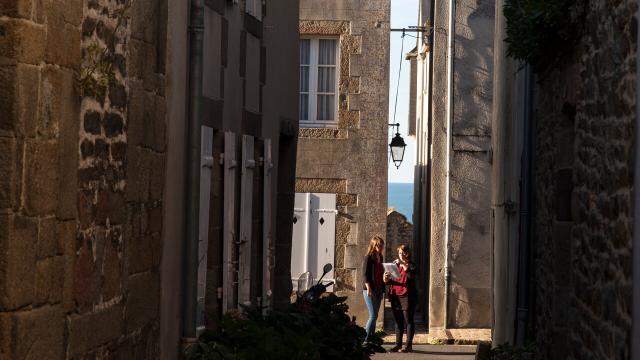 An alleyway in Granville's Upper Town
An alleyway in Granville's Upper TownReaching the top of Rue Notre-Dame, you arrive at Place de l’Isthme. It is divided into two parts by a 19th-century moat. The Richard Anacréon Museum of Modern Art, once a convent and now a school, stands on the western side of the square. As for the famous Tranchée aux Anglais, it can be seen from the east, when you come to tickle the spires of the Casino. From this vantage point, it’s easy to understand the importance of Granville’s seaside tourism boom. Casino, hotels or former hotels, promenade dyke, bathing cabins… One look from these heights and your mind is on vacation… If you want to get back to where you started, you can take the staircase on the north side, the one with the white banister. It leads directly down to the casino square.
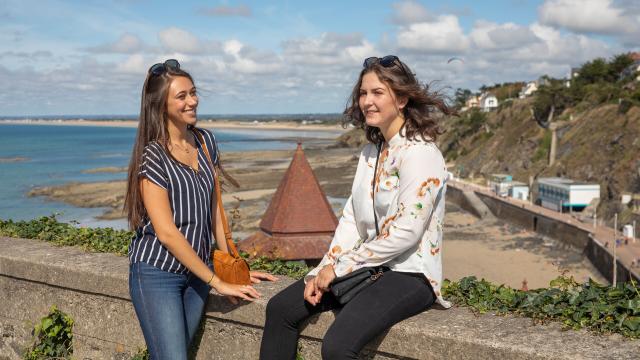 View of the Granville casino and the Plat Gousset beach and promenade from Haute Ville
View of the Granville casino and the Plat Gousset beach and promenade from Haute Ville Crossing the bridge over the ditch at Place de l'Isthme in Granville's Upper Town
Crossing the bridge over the ditch at Place de l'Isthme in Granville's Upper Town